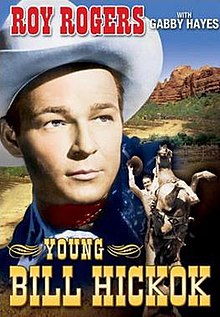Plot
An agent of an unspecified foreign power (John Miljan) plots to take over California during the confusion of the American Civil War. He uses Morrell and his Overland Raiders to prevent news from reaching the east. The Raiders rustle the stagecoach and Pony Express horses from the various relay stations to cut all lines of communication to and from the east. Bill Hickok is sent out to one of the relay stations in hopes that he would be able to keep the ponies from the raiders. Calamity and Gabby, horse traders for the relay stations, ride up with their Indian helpers just as Bill finishes off the last few Raiders that had attacked his post. Bill has been severely hurt so Calamity and Gabby stick around for a while.
During this time, Bill's old fiancée, Louise Mason, shows up. She wants to make up after their breaking their engagement over her support for the Confederacy and Bil's for the North. They agree to forget the war; she and Bill are soon planning a wedding. However, Marshal Evans, head of the communication lines, wants Bill to take a shipment of gold through to the east to support the Federal war effort.
Bill knows it's too dangerous to actually take it himself, the raiders would be sure to get it, so he sends the gold with Gabby and Calamity while pretending to take it himself. The plan backfires when Louise tells Tower that Bill isn't taking the gold to protect Bill from attack. The Raiders attack Gabby and get away with the gold. Bill gets worried when the Raiders don't attack him so he returns to town to see what happened to Gabby. The Marshal wants to know what went wrong and Bill asks for half an hour to find out. After he leaves, Tower convinces the men that Bill is really at the head of the Raiders and that he was getting away. Gabby overhears their conversation so he rides to warn Bill.
Bill gets away for the time being but is captured when he returns to town to search Tower's office. Gabby helps him escape and they see Tower escaping with the gold and the Raiders. Riding back to the posse that pursued them, Bill convinces Marshal to follow them. With Tower and the Raiders locked up and the Civil War ended, Bill and Louise finally get married.

James Butler Hickok, better known as "Wild Bill" Hickok, was a folk hero of the American Old West known for his life on the frontier as a soldier, scout, lawman, cattle rustler, gunslinger, gambler, showman, and actor, and for his involvement in many famous gunfights. He earned a great deal of notoriety in his own time, much of it bolstered by the many outlandish and often fabricated tales he told about himself. Some contemporaneous reports of his exploits are known to be fictitious, but they remain the basis of much of his fame and reputation.

George Francis "Gabby" Hayes was an American actor. He began as something of a leading man and a character player, but he was best known for his numerous appearances in B-Western film series as the bewhiskered, cantankerous, but ever-loyal and brave comic sidekick of the cowboy stars Roy Rogers and John Wayne.
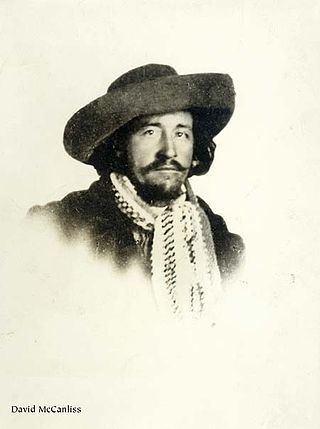
The McCanles Gang was an alleged outlaw gang active in the early 1860s that was accused of train robbery, bank robbery, cattle rustling, horse theft, and murder. On July 12, 1861, some of its supposed members, including alleged leader David Colbert McCanles, were killed by "Wild Bill" Hickok during a confrontation at a Pony Express station in the Nebraska Territory. The incident was among the earliest to frame Hickok's later reputation as a legendary gunfighter.

The Plainsman is a 1936 American Western film directed by Cecil B. DeMille and starring Gary Cooper and Jean Arthur. The film presents a highly fictionalized account of the adventures and relationships between Wild Bill Hickok, Calamity Jane, Buffalo Bill Cody, and General George Custer, with a gun-runner named Lattimer as the main villain. The film is notorious for mixing timelines and even has an opening scene with Abraham Lincoln setting the stage for Hickok's adventures. Anthony Quinn has an early acting role as an Indian. A remake using the same title was released in 1966.

Raymond William Hatton was an American film actor who appeared in almost 500 motion pictures.
The Great Adventures of Wild Bill Hickok (1938) is a Columbia Pictures movie serial. It was the fourth of the 57 serials released by Columbia and the studio's first Western serial. The serial was the first to be produced by Columbia personnel; Columbia's previous three serials had been produced by the independent Weiss Brothers company, using Columbia's facilities.
Sally Payne was an American actress. She featured in several B-Westerns in the 1940s.

Wild Bill is a 1995 American biographical Western film about the last days of legendary lawman Wild Bill Hickok. The film was written and directed by Walter Hill, and based on the 1978 stage play Fathers and Sons by Thomas Babe and the 1986 novel Deadwood by Pete Dexter. It stars Jeff Bridges, Ellen Barkin, John Hurt, and Diane Lane, and was released by United Artists on December 1, 1995. It was a box-office bomb, grossing $2.1 million on a budget of $30 million, and received mixed reviews from critics.
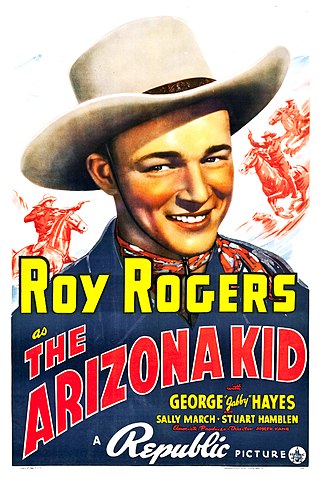
The Arizona Kid is a 1939 American Western film directed by Joseph Kane under the Republic Pictures banner. The film stars Roy Rogers as a Confederate officer in Missouri during the American Civil War.

Martha Jane Canary, better known as Calamity Jane, was an American frontierswoman, sharpshooter, and storyteller. In addition to many exploits, she was known for being an acquaintance of Wild Bill Hickok. Late in her life, she appeared in Buffalo Bill's Wild West show and at the 1901 Pan-American Exposition. She is said to have exhibited compassion to others, especially to the sick and needy. This facet of her character contrasted with her daredevil ways helped to make her a noted frontier figure. She was also known for her habit of wearing men's attire.
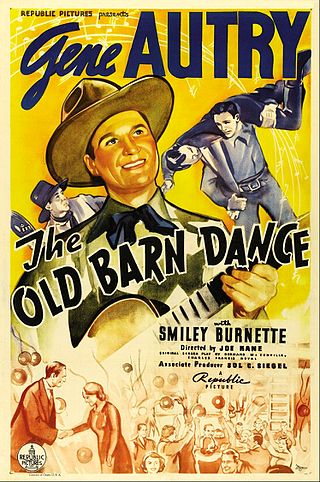
The Old Barn Dance is a 1938 American Western film directed by Joseph Kane and starring Gene Autry, Smiley Burnette, Joan Valerie, and written by Bernard McConville and Charles F. Royal.
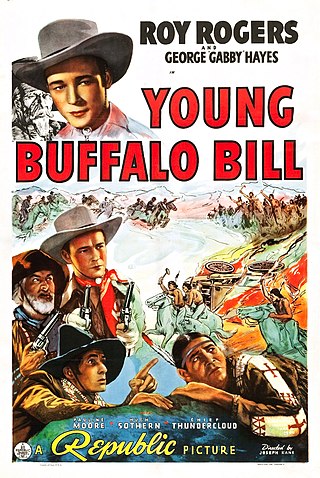
Young Buffalo Bill is a 1940 American Western film directed by Joseph Kane and starring Roy Rogers and George "Gabby" Hayes.
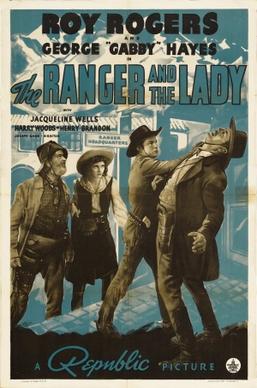
The Ranger and the Lady is a 1940 American Western film directed by Joseph Kane and starring Roy Rogers, and George "Gabby" Hayes.
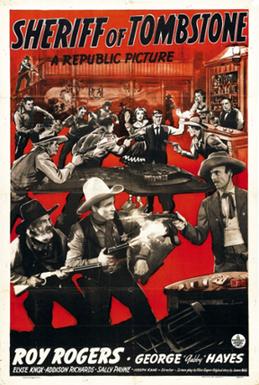
Sheriff of Tombstone is a 1941 American western film directed by Joseph Kane and starring Roy Rogers and George "Gabby" Hayes and Elyse Knox. It was produced and distributed by Republic Pictures.

Bad Man of Deadwood is a 1941 American Western film directed by Joseph Kane and starring Roy Rogers.
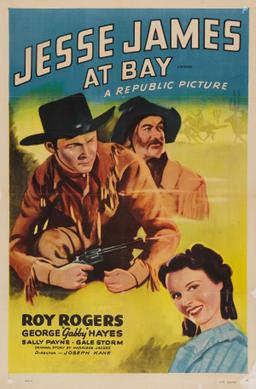
Jesse James at Bay is a 1941 American western film directed by Joseph Kane and starring Roy Rogers, George "Gabby" Hayes and Sally Payne. Roy Rogers plays dual roles in this film. It was produced and distributed by Republic Pictures.

Man from Cheyenne is a 1942 American Western film directed by Joseph Kane and starring Roy Rogers released on January 4, 1942.

Song of Arizona is a 1946 American Western film directed by Frank McDonald and starring Roy Rogers, Dale Evans and George "Gabby" Hayes. It was produced and distributed by Republic Pictures.

Along the Navajo Trail is a 1945 American Western film directed by Frank McDonald and starring Roy Rogers, Gabby Hayes and Dale Evans. The film's story was based on a William Colt MacDonald novel. The film marked the debut of the Cuban actress Estelita Rodriguez, who Republic Pictures then began to build up into a star. Its title song is Along the Navajo Trail, an instrumental version of which appears with the opening credits, with a brief vocal version during the last twenty seconds of the film. The first few bars of the song are used as background music in several chase scenes.
